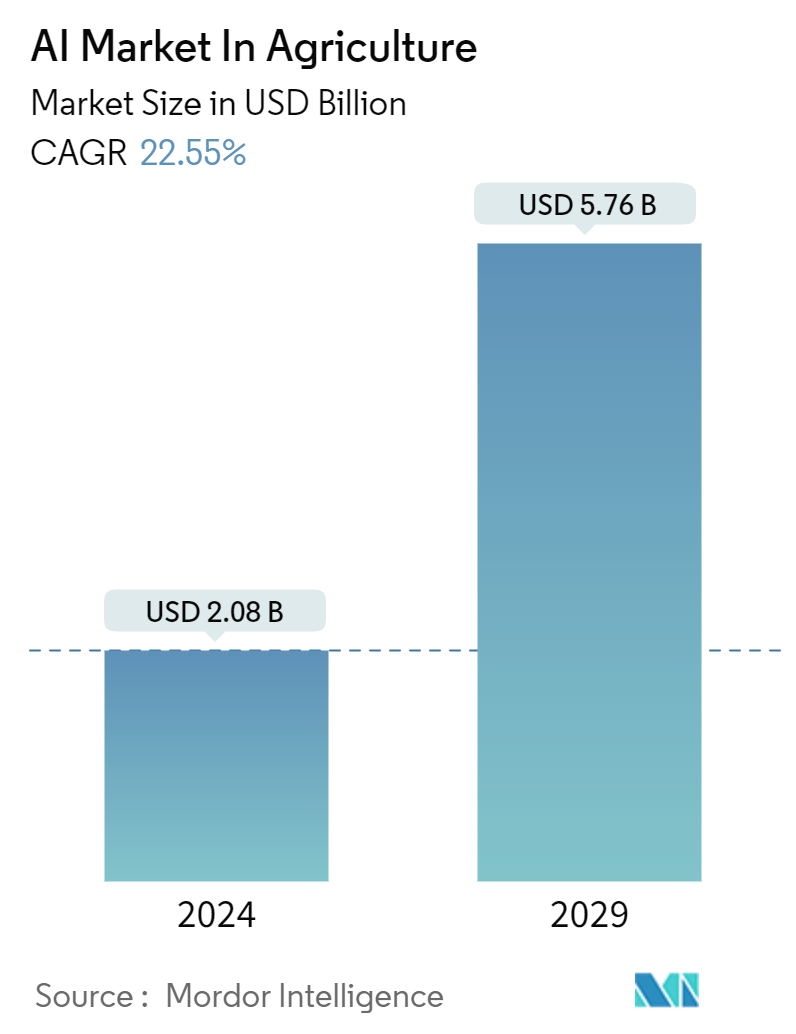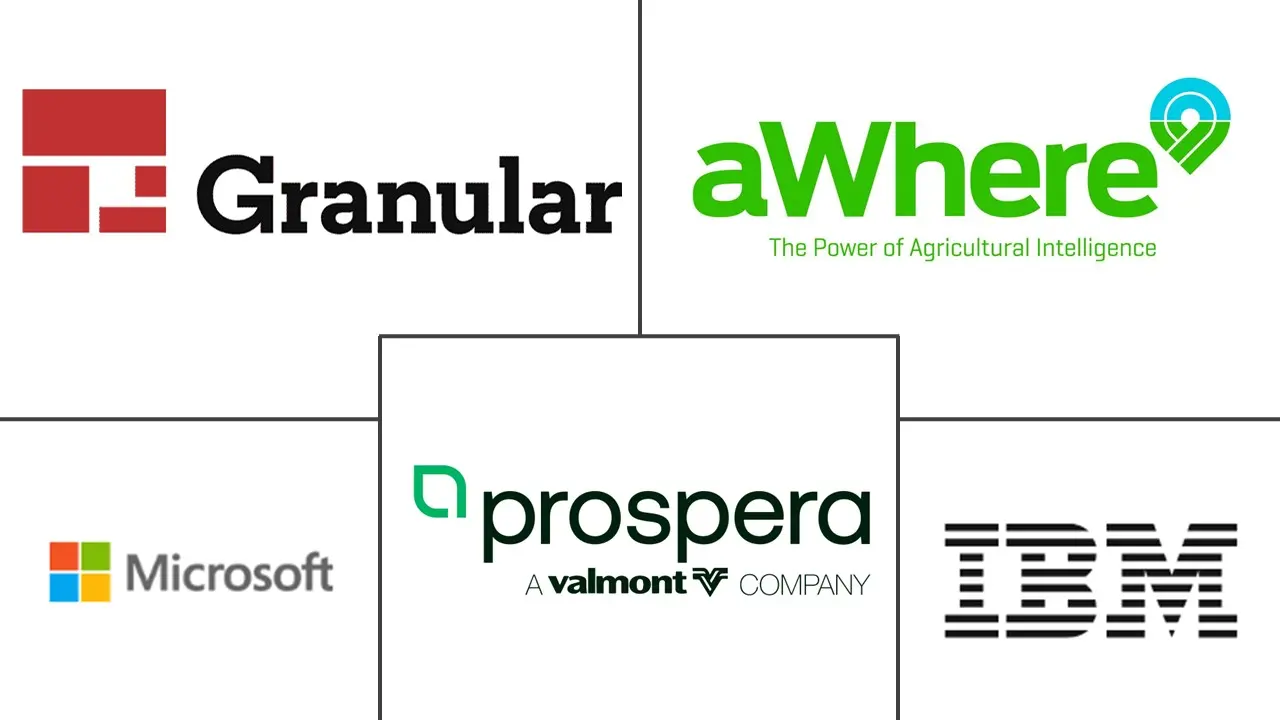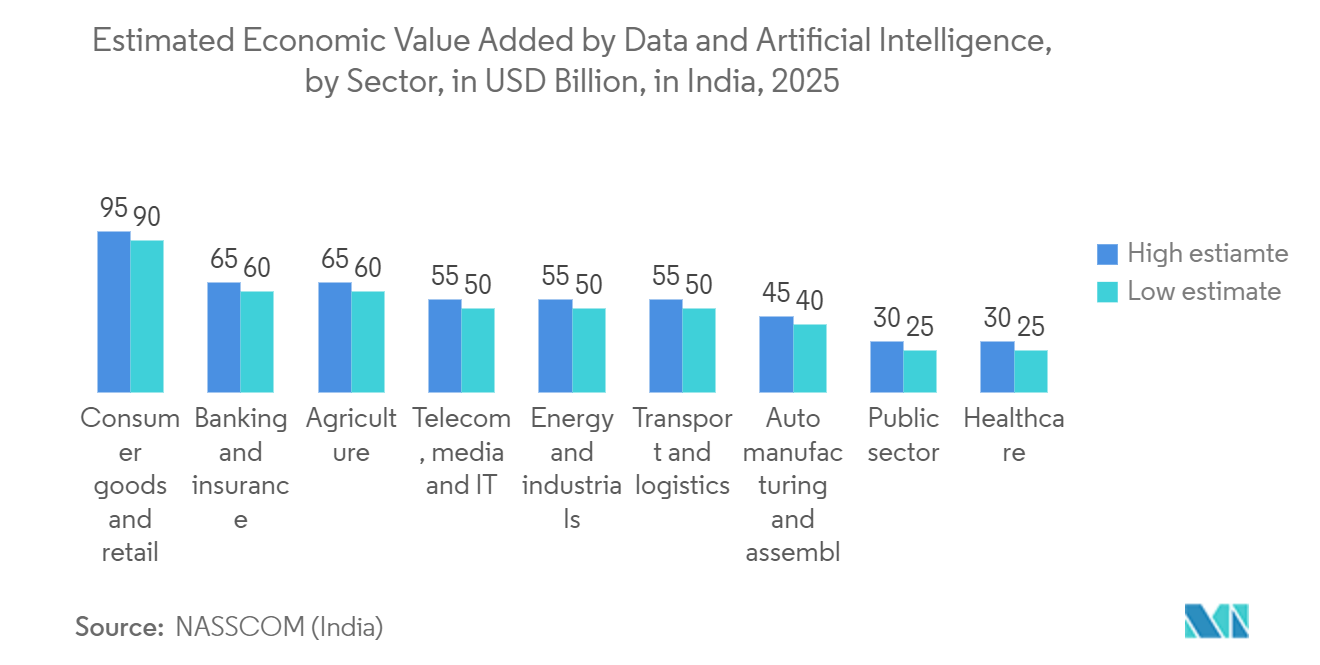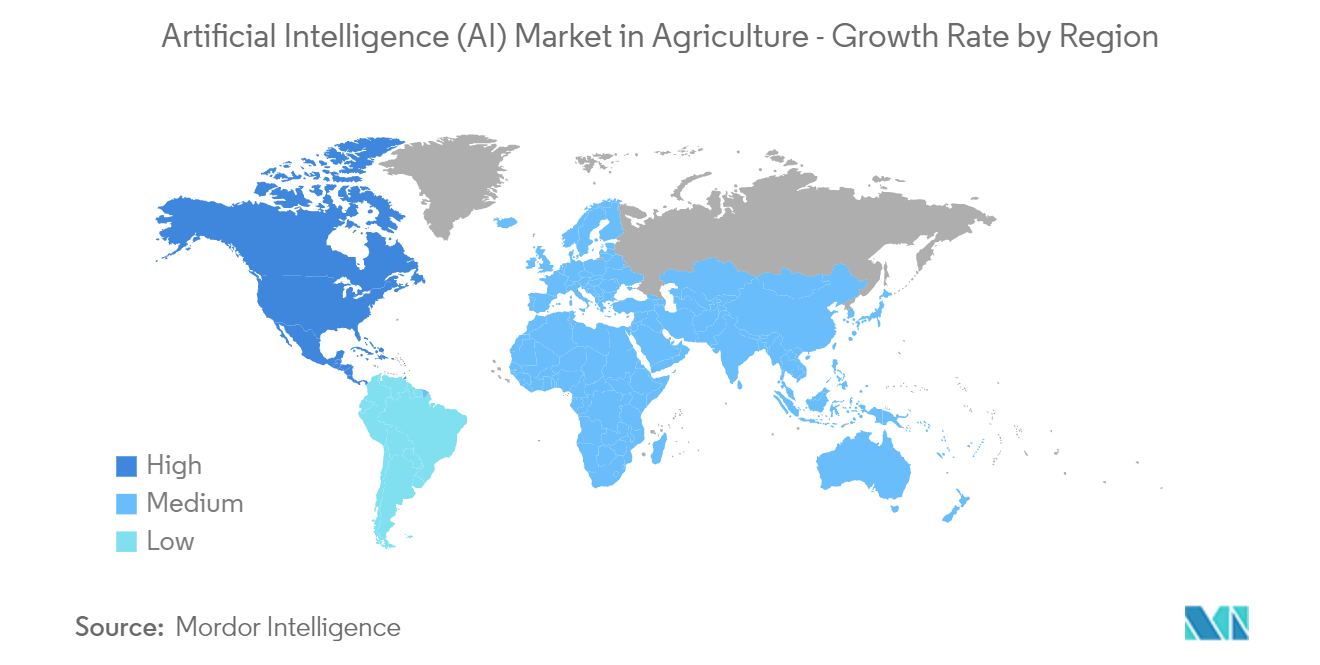Artificial Intelligence (AI) in Agriculture Market Size

| Study Period | 2019 - 2029 |
| Market Size (2024) | USD 2.08 Billion |
| Market Size (2029) | USD 5.76 Billion |
| CAGR (2024 - 2029) | 22.55 % |
| Fastest Growing Market | Europe |
| Largest Market | North America |
Major Players
*Disclaimer: Major Players sorted in no particular order |
Artificial Intelligence (AI) in Agriculture Market Analysis
The AI Market In Agriculture Industry is expected to grow from USD 2.08 billion in 2024 to USD 5.76 billion by 2029, at a CAGR of 22.55% during the forecast period (2024-2029).
The driverless tractor is trending in the market, as these tractors can steer automatically using GPS-based technology, lift tools from the ground, recognize the boundaries of a farm, and be operated remotely using a tablet. A fleet of smaller automated tractors could raise farmer revenue by more than 10 percent and reduce farm labor costs.
- Maximizing crop yield using machine learning techniques is driving the market. Species selection is a tedious process of searching for specific genes that determine water and nutrient use effectiveness, adaptation to climate change, disease resistance, nutrient content, or a better taste. Machine learning, in particular deep learning algorithms, takes decades of field data to analyze crop performance in various climates. Based on this data, one can build a probability model to predict which genes will most likely contribute a beneficial trait to a plant.
- An increase in the adoption of cattle face recognition technology is driving the market. By applying advanced metrics, including cattle facial recognition programs and image classification incorporated with body condition scores and feeding patterns, dairy farms can now individually monitor all behavioral aspects of a group of cattle.
- The increased use of unmanned aerial vehicles (UAVs) across agricultural farms is driving the market, as the use of drones in the agriculture industry can be used in crop field scanning with compact multispectral imaging sensors, GPS map creation through onboard cameras, heavy payload transportation, and livestock monitoring with thermal-imaging camera-equipped drones, which increases the demand for UAVs.
- However, the need for standardization is restraining market growth as the need for data collection and data sharing standards is high. Machine learning, artificial intelligence, and advanced algorithm design have moved quickly, but collecting well-tagged, meaningful agricultural data is way behind.
Artificial Intelligence (AI) in Agriculture Market Trends
Drone Analytics Application Segment is Expected to Hold Significant Market Share
- Integrating drone analytics and AI in agriculture offers tremendous potential for optimizing agricultural operations, reducing costs, and enhancing sustainability. By leveraging the power of AI to analyze drone-captured data, farmers can make data-driven decisions, improve resource allocation, and achieve higher productivity. Therefore, drone analytics is expected to be a significant driver of the AI market in agriculture.
- Drones with high-resolution cameras and sensors can capture vast amounts of data about crops, soil conditions, and field characteristics. Combined with AI-powered analytics, this data enables farmers to gain valuable insights into crop health, nutrient levels, pest infestations, and other factors influencing agricultural productivity.
- AI-powered drone analytics enable precision agriculture practices by providing detailed information about specific areas within a field. By using AI algorithms to analyze drone-captured data, farmers can identify variations in crop growth, soil moisture levels, or pest populations. This allows for targeted interventions, such as precise fertilizers, pesticides, or irrigation applications, leading to optimized resource utilization and increased crop yields.
- Drones equipped with AI-enabled analytics can monitor crops throughout their growth stages. By analyzing drone imagery and sensor data, AI algorithms can detect early signs of plant stress, disease outbreaks, or nutrient deficiencies. Farmers can then take proactive measures, such as adjusting irrigation, applying appropriate treatments, or implementing preventive measures, to mitigate risks and optimize crop health.
- Drone analytics powered by AI enable farmers to efficiently monitor large agricultural areas. Instead of conducting time-consuming manual inspections, AI algorithms can automatically analyze drone-captured data and identify areas requiring attention. This streamlines operations saves labor costs, and allows farmers to make informed decisions based on accurate and timely information. According to NASSCOM, by 2025, approximately USD 90 billion of value will be added to the agriculture sector through data and AI technologies in India. With all the sectors combined, artificial intelligence is projected to add approximately USD 500 billion to India's GDP by 2025.

North America is Expected to Hold Significant Market Share
- The North American artificial intelligence (AI) market in agriculture is a significant segment within the larger agricultural technology industry. The North American AI market in agriculture has been experiencing substantial growth. With the increasing adoption of AI technologies in the agricultural sector, the market is expected to expand significantly in the coming years. Factors such as the need for increased productivity, rising demand for precision farming techniques, and the availability of advanced infrastructure contribute to market growth.
- North American farmers and agricultural businesses embrace AI technologies to improve efficiency, optimize resource allocation, and enhance decision-making processes. AI applications in the region's agriculture industry include precision agriculture, remote sensing, crop monitoring, predictive analytics, and automated farming systems. These technologies help farmers make data-driven decisions, increase yields, reduce costs, and mitigate risks.
- Collaborations between technology providers, agriculture companies, research institutions, and startups characterize the North American AI market in agriculture. These collaborations foster innovation and the development of AI-driven solutions tailored to the specific needs of the region's agricultural sector. Partnerships and investments in AI startups further contribute to market growth and technological advancements.
- Governments in North America recognize the potential of AI in agriculture and are implementing supportive policies and initiatives. These include funding programs, research grants, and regulatory frameworks to foster AI adoption and innovation in the agricultural sector. Such initiatives provide a conducive environment for AI market growth and facilitate the development of sustainable and resilient agricultural practices.
- In January 2023, the United States and the European Union established a collaboration to improve agriculture, climate forecasting, emergency response, and the electric grid through the use of artificial intelligence (AI). The cooperation is now between the European Commission and the White House, the executive arm of the 27-member European Union.

Artificial Intelligence (AI) in Agriculture Industry Overview
- The artificial intelligence (AI) market in the agriculture market is fragmented with major players like Microsoft Corporation, IBM Corporation, Granular Inc., aWhere Inc., and Prospera Technologies Ltd. Players in the market are adopting strategies such as partnerships, collaborations, and acquisitions to enhance their product offerings and gain sustainable competitive advantage.
- In April 2023, IBM and Texas A&M AgriLife collaborated to provide farmers with water consumption insights, which can boost agricultural productivity while lowering economic and environmental expenses. Texas A&M AgriLife and IBM will deploy and grow Liquid Prep, a technology solution that helps farmers decide "when to water" in dry parts of the United States.
- In May 2022, AGRA and Microsoft expanded their collaboration to help with the digital agricultural transformation. AGRA and Microsoft signed an MoU in Davos for future collaboration through its Africa Transformation Office. The organizations will leverage their success from a previous partnership started in 2019, which led to the development of the AgriBot.
Artificial Intelligence (AI) in Agriculture Market Leaders
-
Microsoft Corporation
-
IBM Corporation
-
Granular Inc.
-
aWhere Inc.
-
Prospera Technologies Ltd.
*Disclaimer: Major Players sorted in no particular order
_Market_Concentration.webp)
Artificial Intelligence (AI) in Agriculture Market News
- August 2024: The Union Government unveiled the AI-driven National Pest Surveillance System (NPSS), enabling farmers to consult agricultural scientists and pest control experts directly via their phones. Leveraging AI tools, NPSS will scrutinize up-to-date pest data, assisting both farmers and experts in effective pest management. According to the Ministry, NPSS aims to benefit approximately 140 million farmers nationwide. The Centre envisions this platform as a bridge, linking scientists directly to the agricultural fields.
- July 2024: Google launched its Agricultural Landscape Understanding (ALU) tool, designed to equip farmers with vital agricultural insights and enhance crop yields. This tool, available in limited capacity, seeks to transform agricultural practices into data-driven endeavors. Leveraging high-resolution satellite imagery and machine learning, the ALU will delineate field boundaries and provide insights on drought preparedness, irrigation, and market access, among other features.
Artificial Intelligence (AI) in Agriculture Market Report - Table of Contents
1. INTRODUCTION
- 1.1 Study Assumptions and Market Definition
- 1.2 Scope of the Study
2. RESEARCH METHODOLOGY
3. EXECUTIVE SUMMARY
4. MARKET INSIGHTS
- 4.1 Market Overview
- 4.2 Industry Value Chain Analysis
-
4.3 Industry Attractiveness - Porter's Five Forces Analysis
- 4.3.1 Bargaining Power of Buyers/Consumers
- 4.3.2 Bargaining Power of Suppliers
- 4.3.3 Threat of New Entrants
- 4.3.4 Threat of Substitute Products
- 4.3.5 Intensity of Competitive Rivalry
- 4.4 Analysis on the impact of COVID-19 on the Artificial Intelligence (AI) Market in Agriculture
5. MARKET DYNAMICS
-
5.1 Market Drivers
- 5.1.1 Maximize Crop Yield Using Machine Learning technique
- 5.1.2 Increase in the Adoption of Cattle Face Recognition Technology
- 5.1.3 Increase Use of Unmanned Aerial Vehicles (UAVs) Across Agricultural Farms
-
5.2 Market Restraints
- 5.2.1 Lack of Standardization in Data Collection
6. MARKET SEGMENTATION
-
6.1 By Application
- 6.1.1 Weather Tracking
- 6.1.2 Precision Farming
- 6.1.3 Drone Analytics
-
6.2 By Deployment
- 6.2.1 Cloud
- 6.2.2 On-premise
- 6.2.3 Hybrid
-
6.3 By Geography
- 6.3.1 North America
- 6.3.2 Europe
- 6.3.3 Asia
- 6.3.4 Australia and New Zealand
7. COMPETITIVE LANDSCAPE
-
7.1 Company Profiles
- 7.1.1 Microsoft Corporation
- 7.1.2 IBM Corporation
- 7.1.3 Granular Inc.
- 7.1.4 aWhere Inc.
- 7.1.5 Prospera Technologies Ltd.
- 7.1.6 Gamaya SA
- 7.1.7 ec2ce
- 7.1.8 PrecisionHawk Inc.
- 7.1.9 Cainthus Corp.
- 7.1.10 Tule Technologies Inc.
- *List Not Exhaustive
8. INVESTMENT ANALYSIS
9. MARKET OPPORTUNITIES AND FUTURE TRENDS
** Subject To AvailablityArtificial Intelligence (AI) in Agriculture Industry Segmentation
The growing use of robots in agriculture is driving the artificial intelligence (AI) market. The increasing consumption and rising requirement for better yields in crops are fueling the demand for robots in agriculture. Precision farming is in demand, as around 70-80% of the new equipment purchases have been deemed to contain some form of precision farming tools, along with the demand for smart green applications.
The artificial intelligence (AI) market in agriculture is segmented by application (weather tracking, precision farming, drone analytics), deployment (cloud, on-premises, hybrid), and geography (North America, Europe, Asia-Pacific, and rest of the world). The market sizes and forecasts are provided in terms of value in USD for all the above segments.
| By Application | Weather Tracking |
| Precision Farming | |
| Drone Analytics | |
| By Deployment | Cloud |
| On-premise | |
| Hybrid | |
| By Geography | North America |
| Europe | |
| Asia | |
| Australia and New Zealand |
Artificial Intelligence (AI) in Agriculture Market Research FAQs
How big is the Agriculture AI Market?
The Agriculture AI Market size is expected to reach USD 2.08 billion in 2024 and grow at a CAGR of 22.55% to reach USD 5.76 billion by 2029.
What is the current Agriculture AI Market size?
In 2024, the Agriculture AI Market size is expected to reach USD 2.08 billion.
Who are the key players in Agriculture AI Market?
Microsoft Corporation, IBM Corporation, Granular Inc., aWhere Inc. and Prospera Technologies Ltd. are the major companies operating in the Agriculture AI Market.
Which is the fastest growing region in Agriculture AI Market?
Europe is estimated to grow at the highest CAGR over the forecast period (2024-2029).
Which region has the biggest share in Agriculture AI Market?
In 2024, the North America accounts for the largest market share in Agriculture AI Market.
What years does this Agriculture AI Market cover, and what was the market size in 2023?
In 2023, the Agriculture AI Market size was estimated at USD 1.61 billion. The report covers the Agriculture AI Market historical market size for years: 2019, 2020, 2021, 2022 and 2023. The report also forecasts the Agriculture AI Market size for years: 2024, 2025, 2026, 2027, 2028 and 2029.
AI in Agriculture Industry Report
Statistics for the 2024 AI in Agriculture market share, size and revenue growth rate, created by Mordor Intelligence™ Industry Reports. AI in Agriculture analysis includes a market forecast outlook to 2029 and historical overview. Get a sample of this industry analysis as a free report PDF download.



